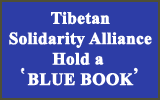Central Tibetan Administration
Click Here to Visit CTA Website
In 1949 the People’s Liberation Army of China marched into Tibet’s eastern provinces of Kham and Amdo, seizing control over the eastern Tibetan headquarters of Chamdo in the following year. Then in 1951, the so-called “17-Point Agreement on Measures for the Peaceful Liberation of Tibet” was forced upon the Tibetan government and people. In the succeeding years, the Chinese army advanced further west and eventually crushed the Tibetan national uprising of Lhasa in 1959. This led to the flight of His Holiness the Dalai Lama and some 80,000 Tibetans who sought refuge in India, Nepal and Bhutan. The influx of refugees continues even today. Currently, the Tibetan exile population is over 140,000, of which about 100,000 are based in India.
On 29 April 1959, His Holiness the Dalai Lama established the Tibetan exile administration in the north Indian hill station of Mussoorie. Named the Central Tibetan Administration (CTA) of His Holiness the Dalai Lama, this is the continuation of the government of independent Tibet. In May 1960, the CTA was moved to Dharamsala.
The Tibetan people, both in and outside Tibet, look to the CTA as their sole and legitimate representative. This and the administration’s commitment to truth, non-violence and genuine democracy as its inviolable principles mean that it is now being recognised increasingly by parliaments and general public round the world as the legitimate and true representative of the Tibetan people.
Right from its inception, the CTA has set itself the twin task of rehabilitating Tibetan refugees and restoring freedom and happiness in Tibet. The rehabilitation agenda includes three important programmes: a) promoting education among the exile population; b) building a firm culture of democracy; and c) paving the way for self-reliance so that the Tibetan people are able to survive with the self-esteem and confidence that flows from not having to depend on external assistance.
The CTA’s experiment with modern democracy, in particular, is a preparation for the reconstruction of Tibet when freedom is restored there. As part of this exercise, a parliament, then named the Commission of Tibetan People’s Deputies, was instituted on 2 September 1960. The parliament gradually matured into a full-fledged legislative body, thus coming to be known as the Assembly of Tibetan People’s Deputies (ATPD). Then in 2006, its name was changed to the Tibetan Parliament-in-Exile (TPiE).
In 1990 His Holiness the Dalai Lama announced further democratisation, by which the composition of the Tibetan Parliament-in-Exile was increased to 46 members. The parliament was empowered to elect the members of the Kashag or the Council of Ministers, which was made answerable to the people’s elected representatives. Similarly, the Tibetan judiciary, known as the Tibetan Supreme Justice Commission, was instituted in 1992 under the provisions of the Arbitration Act of the government of India.
The newly empowered Tibetan parliament issued the exile Tibetan constitution under the title of The Charter of the Tibetans in Exile.
In 2001 the Tibetan parliament, on the advice of His Holiness the Dalai Lama, amended the Charter to provide for direct election of the Kalon Tripa (the highest executive authority) by the exile populace. The Kalon Tripa, in turn, nominates the other Kalons (cabinet members), and seeks the parliament’s approval for their appointment. The first directly-elected Kalon Tripa — Professor Samdhong Rinpoche Lobsang Tenzin — took the oath of office on 5 September 2001. He was elected to the post of Kalon Tripa for the second time in August 2006.
Today, the CTA has all the departments and attributes of a free democratic administration. It must be noted, though, that the CTA is not designed to take power in Tibet. In his manifesto for future Tibet, entitled the Guidelines for Future Tibet’s Polity and Basic Features of its Constitution, His Holiness the Dalai Lama stated that the present exile administration would be dissolved as soon as freedom is restored in Tibet. The Tibetans currently residing in Tibet, he said, would head the government of free Tibet, not by the members of the exile administration. He said that there would be a transitional government in Tibet which would be headed by an Interim-President, elected or appointed by him. To this Interim-President His Holiness would transfer all his temporal power. The Interim-President, in his turn, would be required to hold a general election within two years and then hand over the power to the popularly-elected government.




